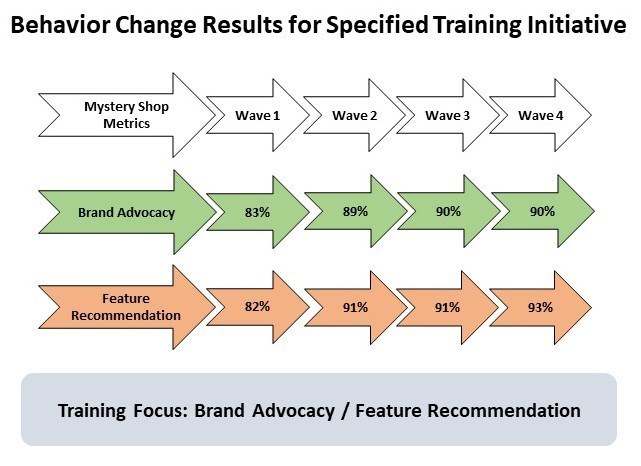Meet Your Business Goals By Changing Behavior
Changing behavior to accomplish a goal is a top priority for most businesses. Employees can train all day long, but unless it results in more sales, better customer experiences, or whatever your goals may be, it’s probably a day misspent. One of the best vehicles to drive behavior change is eLearning. When designed correctly, an eLearning environment delivers positive changes in behavior that are impactful and measurable.
There is a lot to consider when you’re talking about changing behavior across a broad range of people who will participate in your eLearning program. Here are a few areas that I’ve experienced that are key in creating a change in behavior among participants.
Tune Into WIIFM
To change behavior through an eLearning environment, it is critical to address the “What’s in it for me?” (WIIFM) question from the perspective of participants. Much like tuning in to listen to your favorite radio station, it’s important you be tuned in to listen for what matters to participants—and their management.
Participants want to know how they will benefit from the training, the WIIFM. What will they get out of it? Oftentimes, they also want to know if the time they spend training is something that is supported by their managers. Understanding the training objectives of the participant’s management is also part of WIIFM, in that the time spent engaged in training aligns with their company’s goals and objectives.
When there is a clear benefit to undertaking training modules which are also aligned with a company’s objectives, participant and management buy-in are much greater. Whether it helps advance their careers, provides opportunities to earn rewards, increases sales closure rates, or other benefits, make the WIIFM clear from the outset to show the value of participating in the eLearning program.
Incorporate All Learning Styles Into Training
To foster change, you need to incorporate trainings that appeal to various learning styles. It is common for people to present information in the way they generally like to learn. One thing to be particularly mindful of when developing an eLearning program is to refrain from inserting your personal learning style into all trainings. You need to remove yourself from the equation to allow for all learning styles to have the same access to that information.
There are various models of learning styles out there, but they can generally be broken down into 3 categories:
- Visual
Consider trainings that include articles, images, videos, diagrams, or infographics. - Auditory
Consider trainings that include recordings, podcasts, or webcasts. - Kinesthetic
Consider trainings that include hands-on activities, role-playing, reading, or note-taking.
Create training material that engages all types of learning styles and offers multiples ways for participants to master the information you want them to know.
Create A Dependable Training Roadmap
To keep people engaged and returning to your program, they need to know what’s coming. A dependable training calendar or roadmap can help them do this. Consider tying the roadmap to seasons, holidays, or something that is memorable and relatable to your participants. This will be an important element to keep them coming back for more training.
The roadmap is equally important to your team responsible for developing trainings. This roadmap will help keep everyone organized and on target for their deliverables.
Keep Trainings Brief
People’s time is a HUGE consideration, so structure your eLearning program with that in mind. Some studies indicate that bite-sized training in increments of 3-7 minutes correlates to the human memory capacity and attention span. Keep trainings brief, bite-sized chunks. This is particularly important for those who are training on their own time.
Be mindful and respectful of their time. If the training is viewed as arduous or time-consuming, participants, particularly those coming voluntarily, won’t come back for more. Remember that many participants view training modules on mobile devices. Shorter videos or interactive trainings are easier to stream and absorb on mobile devices.
Tie trainings to the dependable roadmap to encourage consistent participation. They will know what to expect and it increases the likelihood they will consistently come back for more. Also, consider the value of repetition with brief trainings. This will help your message sink in.
Provide The Opportunity For Feedback
Ensure participants feel a valued part of the training by giving them an opportunity to provide direct feedback on individual trainings and the eLearning program as a whole. One simple way to do this is through the use of comments.
For example, at the end of a training exercise, include a comments field. It can be surprising how much quality insight participants have to offer. Use feedback to improve future trainings on that particular topic or to allow comments in general.
Nurture A Community
Nurture your eLearning community of participants to help change behavior. Giving them the opportunity to provide feedback applies here too. However, there are many other ways you can cultivate a sense of community within your program. Incorporating message boards is one.
Moderate discussions between participants on message boards. People tend to listen to their peer group and not just the presenter of the training. By allowing participants to have conversations within the program, you promote a sense of community that motivates people to return and engage.
Introduce Friendly Competitions
Generate energy and excitement around your eLearning program with a little friendly competition. This is particularly useful when participation in the training is voluntary. Competition can be structured as team vs. team or individual vs. individual. Introduce team competitions to effectively instill key messages and group learning. Structuring the competition in a way where individuals support one another helps drive participation and engagement.
If your eLearning platform has gamification capabilities, competitions present the perfect opportunity to utilize them with leaderboards, team dashboards, badging, and trophies. Competitions make the training experience more fun and the right gamification elements bring them to life virtually.
When properly orchestrated, your competitions turn into nail biters, where eyes are glued to the leaderboards down to the final moments. Friendly competition is a great way to galvanize teams and instill key messages, resulting in behavior change.
Integrate Feedback Loops
Feedback loops help to measure performance and action. Build this into the eLearning program where performance is reported back to the platform. It’s great for team competitions to measure behavior change aligned with specific training initiatives.
For example, in the service industry, mystery shops are a great way to measure performance. If possible, execute in multiple waves over a defined period and report the findings back to your team for correction.

At a minimum, pre- and post-training mystery shops are a must.
Use Assessments
Another way to change behavior is to use pre- and post-training assessments. Understand what the participant knows about the topic before they begin and then assess at the end of the training to see if a greater understanding of comprehension has been achieved.
Pre- and post-assessments benefit both the participant and the eLearning program team. These types of assessments reveal gaps in knowledge and skills that can be used by participants to gauge their growth. They are also helpful for the program to identify additional trainings that are needed and the effectiveness of existing trainings.
Changing Behavior For The Better
To change behavior—for the better—the eLearning environment should be based on reciprocity. It can’t be all about your brand. The training program must also benefit participants. To achieve maximum success, employees and their managers should perceive the program as highly valuable to their own efforts.
The examples given above can be incorporated into eLearning environments for most any industry or for companies who want to change behavior within their own walls. It’s not an exhaustive list by any means, but we have seen them used successfully in an eLearning environment to bring about behavior change that benefitted everyone involved.
What elements have you included in your eLearning environment that help to drive a positive change in behavior? I’d welcome the opportunity to learn more about them.









